Cooling Load Calculation for cold rooms. In this article we’ll be looking at how to calculate the cooling load for a cold room. We’ll first look at the heat sources and then we’ll look at a worked example of how to perform a cold room cooling load calculation in a simplified example. Scroll to the bottom to watch the video tutorial.
Want free cold room calculation design software?
Download Coolselector®2 for free -> Click here
With Danfoss, you can build sustainable and efficient cold rooms. Their wide range of products and market-leading application expertise enable you to think ahead and meet future refrigerant and energy regulations. Go green and get ahead of competition without
compromising on performance.
Learn more about Cold Room solutions here
What is a cold room?
A cold room is used to store perishable goods such as meat and vegetables to slow down their deterioration and preserve them as fresh as possible for as long as possible. Heat accelerates their deterioration so the products are cooled down by removing the heat.
To remove the heat we use a refrigeration system as this allows accurate and automatic control of the temperature to preserve the goods for as long as possible.

To remove the heat we need to know what the cooling load will be. The cooling load varies throughout the day so in most cases the average cooling load is calculated and the refrigeration capacity is calculated to suit this.
Cold Room Heat Sources
Where does all the heat come from that we need to remove?
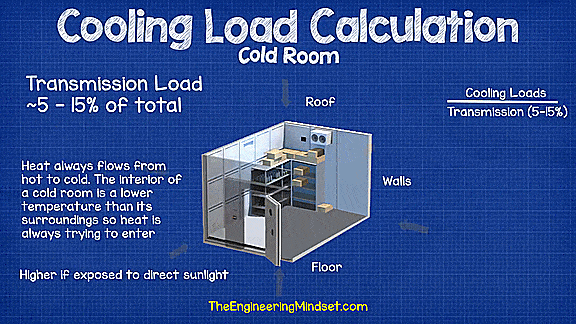
Typically 5-15% is through transmission loads. This is the thermal energy transferred through the roof, walls and floor into the cold room. Heat always flows from hot to cold and the interior of the cold room is obviously a lot colder than its surroundings, so heat is always trying to enter the space because of that difference in temperature. If the cold store is exposed to direct sunlight then the heat transfer will be higher so an additional correction will need to be applied to allow for this.
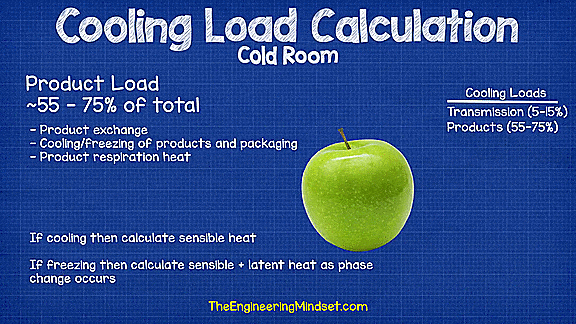
Then we have Product loads which account for typically 55-75% of the cooling load. This accounts for the heat that is introduced into the cold room when new products enter. Its also the energy required to cool, freeze and further cool after freezing. If you’re just cooling the products then you only need to consider the sensible heat load. If you’re freezing the product then you need to account for the latent heat also as a phase change occurs. During this time energy is used but you will not see a temperature change while the product changes between a state of liquid and ice. There is additional energy required to further chill this food down below the freezing point which is again sensible heat. You also need to account for the packaging as this will inherently be cooled also. Lastly if you’re cooling fruit and vegetables then these products are alive and they will generate some heat so you’ll need to account for the removal of this too.

The next thing to consider is the internal loads which account for around 10-20%. This is the heat given off by people working in the cold room, the lighting and equipment such as fork lifts trucks etc. So for this you’ll need to consider what equipment will be used by the staff members in order to move the products in and out of the store, how much heat will they and the equipment give off and the daily duration.
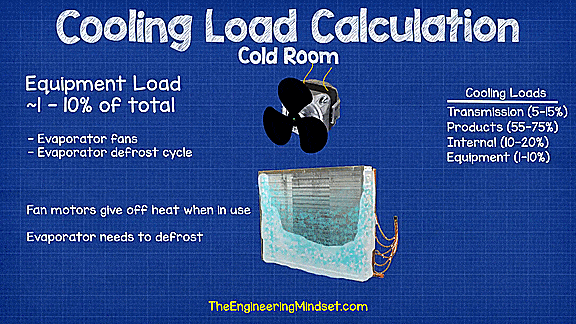
Then we need to consider the refrigeration equipment in the room which will account for around 1-10% of the total cooling load. For this we want to know the rating of the fan motors and estimate how long they will run for each day, then we want to also account for any heat transferred into the space from defrosting the evaporator.
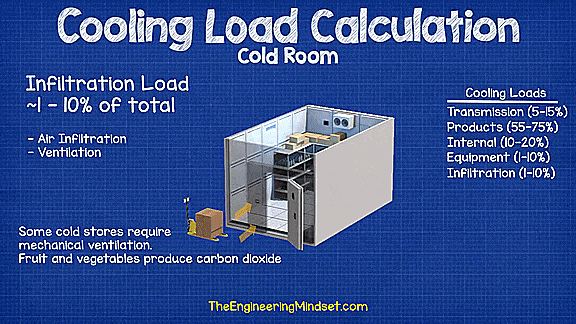
The last thing we need to consider is infiltration which again adds 1-10% to the cooling load. This occurs when the door opens so there is a transfer of heat into the space through the air. The other consideration is ventilation. Fruit and vegetables give off carbon dioxide so some stores will require a ventilation fan, this air needs to be cooled down so you must account for this if it’s used.
Cooling load calculation – Cold room worked example
Lets consider a simplified example of a cooling load calculation for a cold room. Now If you’re doing this for a real world example then I recommend you use a design software such as the Danfoss coolselector app for speed and accuracy. Download here –> http://bit.ly/2Ars6yF
Transmission load
- The dimensions of our cold store are 6m long, 5m wide and 4m high.
- The ambient air is 30°c at 50% RH, The internal air is 1°C at 95% RH
- The walls, roof and floor are all insulated with 80mm polyurethane with a U value of 0.28W/m2.K
- The ground temperature is 10°C.
Just to note the manufacturer should tell you what the u value is for the insulation panels, if not, then you will need to calculate this.
To calculate the transmission load we will be using the formula
Q = U x A x (Temp out – Temp in) x 24 ÷ 1000.
- Q= kWh/day heat load
- U = U value of insulation (we already know this value) (W/m2.K)
- A = surface area of walls roof and floor (we will calculate this) (m2)
- Temp in = The air temperature inside the room (°C)
- Temp out = The ambient external air temperature (°C)
- 24 = Hours in a day
- 1000 = conversion from Watts to kW.
To calculate “A” is fairly easy, its just the size of each internal walls, so drop the numbers in to find the area of each wall, roof and floor.
Side 1 = 6m x 4m = 24m2
Side 2 = 6m x 4m = 24m2
Side 3 = 5m x 4m = 20m2
Side 4 = 5m x 4m = 20m2
Roof = 5m x 6m = 30m2
Floor = 5m x 6m = 30m2
Then we can run these numbers in the formula we saw earlier, you’ll need to calculate the floor separately to the walls and roof as the temperature difference is different under the floor so the heat transfer will therefore be different.
Walls and roof
Q = U x A x (Temp out – Temp in) x 24 ÷ 1000
Q = 0.28W/m2.K x 113m2 x (30°C – 1°C) x 24 ÷ 1000
Q = 22 kWh/day
[113m2 = 24m2 + 24m2 + 20m2 + 20m2 + 30m2 + 30m2 ]
Floor
Q = U x A x (Temp out – Temp in) x 24 ÷ 1000
Q = 0.28W/m2.K x 30m2 x (10°C – 1°C) x 24 ÷ 1000
Q = 1.8 kWh/day
If the floor isn’t insulated then you will need to use a different formula based on empirical data.
Total daily transmission heat gain = 22kWh/day + 1.8kWh/day = 23.8kWh/day
Remember if your cold room is in direct sunlight you’ll need to account for the suns energy also.
Product load – Product exchange
Next we will calculate the cooling load from the product exchange, that being the heat brought into the cold room from new products which are at a higher temperature.
For this example we’ll be storing apples, we can look up the specific heat capacity of the apples but do remember if you’re freezing products then the products will have a different specific heat when cooling, freezing and sub cooling so you’ll need to account for this and calculate this separately, but in this example we’re just cooling.
There are 4,000kg of new apples arriving each day at a temperature of 5°C and a specific heat capacity of 3.65kJ/kg.°C.
We can then use the formula
Q = m x Cp x (Temp enter – Temp store) / 3600.
- Q = kWh/day
- CP = Specific Heat Capacity of product (kJ/kg.°C)
- m = the mass of new products each day (kg)
- Temp enter = the entering temperature of the products (°C)
- Temp store = the temperature within the store (°C)
- 3600 = convert from kJ to kWh.
Calculation
Q = m x Cp x (Temp enter – Temp store) / 3600
Q = 4,000kg x 3.65kJ/kg.°C x (5°C – 1°C) / 3600.
Q = 16kWh/day
Product load – Product respiration
Next we calculate the product respiration, this is the heat generated by living products such as fruit and vegetables. These will generate heat as they are still alive, that’s why we’re cooling them to slow them down their deterioration and preserve them for longer.
For this example I’ve used 1.9kJ/kg per day as an average but this rate changes over time and with temperature. In this example we’re using a rules of thumb value just to simplify the calculation since this cooling load is not considered critical. If you were to calculate for a critical load you should use greater precision. In this example the store maintains a hold of 20,000kg of apples.
To calculate this we’ll use the formula
Q = m x resp / 3600
- Q = kWh/day
- m = mass of product in storage (kg)
- resp = the respiration heat of the product (1.9kJ/kg)
- 3600 = converts the kJ to kWh.
Q = m x resp / 3600
Q = 20,000kg x 1.9kJ/kg / 3600
Q = 10.5kWh/day
For the product section we’ll sum together the product exchange of 16kWh/day and respiration load of 10.5kWh/day to get a total product load of 26.5 kWh/day.
Internal heat load – People
Next we’ll calculate the internal loads from people working in the cold room, as people generate heat and we need to account for this.
We’ll estimate 2 people working in the store for 4 hours a day and we can look up and see at this temperature they will give off around 270 Watts of heat per hour inside.
We’ll use the formula:
Q = people x time x heat / 1000
- Q = kWh/day
- people = how many people inside
- time = length of time they spend inside each day per person (Hours)
- heat = heat loss per person per hour (Watts)
- 1,000 just converts the watts into kW
Calculation:
Q = people x time x heat / 1000
Q = 2 x 4 hours x 270 Watts / 1000
Q = 2.16 kWh/day
Internal heat load – Lighting
Then we can calculate the heat generated by the lighting, this is fairly simple to do and we can use the formula
Q= lamps x time x wattage / 1000
- Q = kWh/day,
- lamps = number of lamps within the cold room
- time = hours of use per day
- wattage = power rating of the lamps
- 1000 = converts the Watts to kW.
If we have 3 lamps at 100W each, running for 4 hours a day, the calculation would be:
Q= lamps x time x wattage / 1000
Q= 3 x 4 hours x 100W / 1000
Q= 1.2kWh/day
For the total internal load we then just sum the people load (2.16 kWh/day) and lighting load (1.2kWh/day) to get a value of 3.36kWh/day.
Equipment load – fan motors
Now we can calculate the heat generation of the fan motors in the evaporator. For this we can the use the formula of:
Q = fans x time x wattage / 1000
- Q = kWh/day
- fans = the number of fans
- time = fan daily run hours (hours)
- wattage = the rated power of the fan motors (Watts)
- 1000 = convert from watts to kw.
In this cold room evaporator we’ll be using 3 fans rated at 200W each and estimate that they will be running for 14 hours per day.
Calculation:
Q = fans x time x wattage / 1000
Q = 3 x 14 hours x 200W / 1000
Q = 8.4kWh/day
Equipment load – fan motors
Now we will calculate the heat load caused by defrosting the evaporator. To calculate this we’ll use the formula:
Q = power x time x cycles x efficiency
- Q = kWh/day,
- power = power rating of the heating element (kW)
- time = defrost run time (Hours)
- cycles = how many times per day will the defrost cycle occur
- efficiency = what % of the heat will be transferred into the space.
In this example our cold room uses an electric heating element rated at 1.2kW, it runs for 30 minutes 3 times per day and the estimate that 30% of all the energy it consumes is just transferred into the cold room.
Q = power x time x cycles x efficiency
Q = 1.2kW x 0.5hours x 3 x 0.3
Q = 0.54kWh/day
The total equipment load is then the fan heat load (8.4kWh/day) plus the defrost heat load (0.54kWh/day) which therefore equals 8.94 kWh/day
Infiltration load
Now we need to calculate the heat load from air infiltration. I’m going to use a simplified equation but depending on how critical your calculation is then you may need to use other more comprehensive formulas to achieve greater precision. We will use the formula:
Q = changes x volume x energy x (Temp out – Temp in ) / 3600
- Q = kWh/d
- changes = number of volume changes per day
- volume = the volume of the cold store
- energy = energy per cubic meter per degree Celsius
- Temp out is the air temperature outside
- Temp in is the air temperature inside
- 3600 is just to convert from kJ to kWh.
We’ll estimate that there will be 5 volume air changes per day due to the door being open, the volume is calculated at 120m3, each cubic meter of new air provides 2kJ/°C, the air outside is 30°C and the air inside is 1°C
Q = changes x volume x energy x (Temp out – Temp in ) / 3600
Q = 5 x 120m3 x 2kJ/°C x (30°C – 1°C ) / 3600
Q = 9.67 kWh/day
Total cooling load
To calculate the total cooling load we will just sum all the values calculated
Transmission load: 23.8kWh/day
Product load: 26.5 kWh/day
Internal load: 3.36kWh/day
Equipment load: 8.94 kWh/day
Infiltration load: 9.67 kWh/day
Total = 72.27 kWh/day
Safety Factor
We should also then apply a safety factor to the calculation to account for errors and variations from design. Its typical to add 10 to 30 percent onto the calculation to cover this, I’ve gone with 20% in this example so well just multiply the cooling load by a safety factor of 1.2 to give us our total cooling load of 86.7 kWh/day
Refrigeration cooling capacity sizing
The last thing we need to do is calculate the refrigeration capacity to handle this load, a common approach is to average the total daily cooling load by the run time of the refrigeration unit. For this I’m estimating the unit to run 14 hours per day which is fairly typical for this size and type of store. Therefore our total cooling load of 86.7kWh/day divided by 14 hours means our refrigeration unit needs to have a capacity of 6.2kW to sufficiently meet this cooling load.

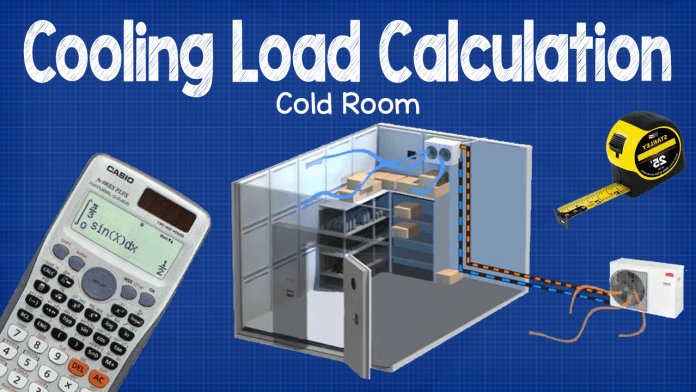




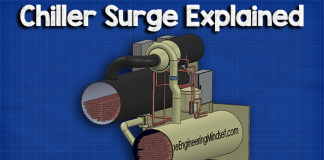












hello,i am HVAC student:
Thermostatic expansion valve is a throttling device used for flow control of refrigerant in the refrigeration system. Throttling is done to reduce the boiling point of the liquid from the condenser. this is achieved by reducing the presure of the refrigerant as it is metered through the small orifice of the throttling device. As the pressure reduces, the boiling temperature of the refrigerant also reduces
Heat pumps
When a friend of mine brought up learning about load calculations I became interested too. She wants to make sure that this service will help her get to a temperature she needs. I will let her know that cooling products only means accounting for the sensible heat load.
Hi
For the sample calculation, you have estimated that the unit runs 14 hours per day. Can I find out how this basis is derived? The refrigeration cooling should be running on 24hours less the defrosting duration (ie duration that the cooler is not running) and in your example, you have used 3 defrost cycles in a day of 30mins per cycle. Shouldn’t the unit be running for (24 – 3*30mins) 22.5hrs instead of 14 or are there any other factors that may have made the unit run lesser hours that I am unaware of?
The load is the time that the compressor will actually be running to remove the heat content. There is never a 100% load on the unit otherwise the compressor would never shut down and any extra load(because the load varies from hour to hour and day to day) would mean the unit can not do it”s job
The Unit temperature controller is normally set as Start at -18 deg Cel and Stop at -21 deg cel for meat section. For Veg its set as Start at 10 deg cel and stop at 4 deg cel. Now initially when the cold rooms are at normal ambient temp and the products inside are also at ambient temp then it takes 7 to 8 hours for reaching the set temp. When the set temp is reached and the system stops then it takes atleast 30 to 60 minutes when the system starts again as the cold room temp raises. When we calculate and consider all these off times and the defrost times, the system’s normal running time is never more than 16 hours. Its always between 8 to 14 hours.
Ali
Marine Chief Engineer.
20 years Working Experience with Danfoss Systems.
For the Transmission load
Q = U x A x (Temp out – Temp in) x 24 ÷ 1000.
Temp in and out must be in Kelvin (K) as you have (K) in the value of U that you have used (0.28W/m2.K)
Doesn’t matter difference between temperatures remains the same
Q = 0.28W/m2.K x 30m2 x [(10°C +273)– (1°C+273)]x 24 ÷ 1000
273 will cancel out
For the Transmission load
Temp in and out must be in Kelvin (K) as you have (K) in the value of U that you have used (0.28W/m2.K)
HOW WE WILL CALCULATE THE COOLING LOAD OF A ROOM IF THE ROOM IS SURROUNDED BY CONDITIONED AIR ,WHAT WE WILL GIVE TO THE OUTSIDE THE OUTSIDE DRY BULB TEMP VALUE
My logic dictates that, if you separate the areas into several formulas and add them up, then you get the real cooling load IE: Grab only the south wall and calculate Q (If the temperature is the same, then the value will be 0, you can negate that wall), then do the same for the rest of the walls, the roof and the floor (if the floor is sitting directly to the ground, you can negate the effect, the temperature will eventually stop leaking on that direction). Add all of your Qs to get the final result.
This calculation does not stop here. You will have to select the equipment’s ( Evaporator & Condensing Unit) and then rate them to 72.27kWh/day
please help to compute heat load of 500 kg per hr of pasta . I need to provide cooling Air Conditioning for cooling pasta from its temperatute 35 deg C to 5 deg C
Correction,
Actually rate to 86.7 kWh/day and not 72.27 kWh/day as stated earlier
Side 1 = 6m x 4m = 24m2
Side 2 = 6m x 4m = 24m2
Side 3 = 5m x 4m = 20m2
Side 4 = 5m x 4m = 20m2
Roof = 5m x 6m = 30m2
Floor = 5m x 6m = 30m2
Then we can run these numbers in the formula we saw earlier, you’ll need to calculate the floor separately to the walls and roof as the temperature difference is different under the floor so the heat transfer will therefore be different.
Walls and roof
Q = U x A x (Temp out – Temp in) x 24 ÷ 1000
Q = 0.28W/m2.K x 113m2 x (30°C – 1°C) x 24 ÷ 1000
Q = 22 kWh/day
[113m2 = 24m2 + 24m2 + 20m2 + 20m2 + 30m2 + 30m2 ]
I would check your calcs if i were you and at this point its not the floor added either.
Nice explanation buddy, thanks for sharing
A/c:for 1000sq/ft we need one ton=12000 BTUH
For refrigeration we’ve to calculate that how much stuff we need to cool down or freeze
For heating total area of the building or house
Area X 30=total BTUH we need to warmup a building or house. How solved this question
for which application you 1 ton for 1000Sq/ft
I think you mean for 100 sq f we use on ton.
will there be any air changes
Why each cubic meter of new air provides 2kJ/°C ?
Specific heat of air at 25°C is 1.005kj/kg°C
how to calculate respiration heat of any product?
Qr = m × resp / 3600 (kW)
Heat of respiration of product (ASHRAE Handbook – Refrigeration)
In SI system
resp value mW/kg
Can be change W/kg (mW=0.01W)
And then change kj/kg (W/kgx24x3.6)
Onion resp value is 0.046 W/kg
0.046 x 24 x 3.6= 3.94 kj/kg
50000kg x 3.94 / 3600 = 54.71 kWh/day
Other methed
m × resp x 24 / 1000 (kW)
50000kg x 0.046 x 24 / 1000 = 54.71 kWh/day
Note: 24 is hours per day.
Hi , do you have any easy calculator version , such as I can fil up size of room + room’information and tempearture then we know capacity of equipment ?
Yes, click the link in the article for Coolselector
Hi how do we use this value to determine the required compressor power
Hello,
Is the refrigeration cooling capacity the same as the cooling power on an air conditioning unit?
Also, how is the refrigeration cooling capacity relate to BTU?
Thanks!
how much TR required to room 12x7x7mts to make it meat store at -20deg whaen 25% of the area of the room is covered by meat please can any one tell me to ton rate for this
What is the role of humidity. for instant if I want to maintain high humidity 95% using a humidifier. How I can calculate the latent load.
WALLS AREA +ROOF AREA = 118 M2 NOT 113
Kindly to advice what cooling capacity do i need for a warehouse of Height 9m x With 15m x length 40m and indoor temp to maintain at 22 degree c
How i will calculate kwh electricity required in chiller,blast if size of chiller is 20mx10mx3m. And blast 10m x10m x 3m. Ammonia Refrigerant is used. Running hours will be 10 hrs. Per day and product store in chiller and blast is chicken .
Can you please show how did you calculate how many hours the fans are running?
sir, i am using your example as a guide to determine the electrical power needed for a similar project. 10mx5mx5m and i lowered the temp to -15deg c.however i noticed that you divided the total kwh/day by 14hrs to arrive at the final figure, but isnt 14hrs a fraction of the day hence the value should be 14/24=0.58 and then do the x
please help to compute heat load of 500 kg per hr of pasta . I need to provide cooling Air Conditioning for cooling pasta from its temperatute 35 deg C to 5 deg C
would be interested to know for what cooling capacity be needed for a space area of Height 7m x Width 18m x Length 36m, indoor temperature to maintain at 22 degree Celsius and Surface area A 3-sided double glass materials. I believe the calculation for Transmission Load factor A factor must be different. Please advice and thank you for your attention.
This is exactly how I do such design tasks, but others emphasise that it’s better to use the pull down period approach. What’s the calculation procedure for the pull down time?
Hi would anyone know of how to calculate the refrigeration capacity of a system that isrequired to remove 3.5t of beef, the beef is to be frozen within 8 hours. The beef enters the freezer pre chilled at 4°c and the required storage is -25°c
How do we calculate the cooling load of the room if the room is not surrounded by conditioned air and it needs to be heated as well
Q = U*A*∆T in j/sec or (Watts) is basic formula for convocation heat transfer which gives heat transfer in 1 second
To get heat transfer in entire day we have to multiply answer with
60*60*24
You missed 60*60
Also you sum all six sides area in roof & wall heat transfer calculatio
But without floor the area is 83 m^2
Thank you so much for writing such amazing, knowledge rich article.
why temperature of apple inter to cold room is 5C ?
why is not 30
Cooling load of a hall in UAE size:- L=66 feet x W= 43 feet x 33 feet high
How do you calculate the U value
Should we consider the capacity of water cooled condenser of an ammonia refrigeration system, when we calculate the requirement of compressors?
I have cooling load of 1600KWH in my water chilling plant, how much power rated compressors should i need with forced draft water cooling condenser unit.